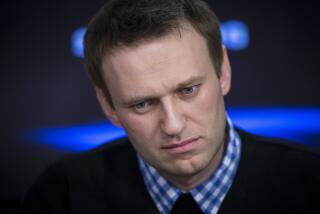A sparkling portrait, but the sitter’s still sketchy
- Share via
T.J. BINYON’S “Pushkin,” winner of the Samuel Johnson Prize for biography in England, has arrived in America. In this handsome volume of more than 700 pages, the reader is greeted by a typical page from one of Pushkin’s working notebooks. Caricatured male profiles, stylized female profiles with upswept hairdos, figures in expressive motion, fetishistic legs and feet, historical personages, friends, lovers, enemies and the occasional sword or pistol bloom crazily along the margins and between lines of poetry. If it were possible to photograph an imagination at work and creatively “idling,” this would be it. Clearly, this poet lived in a social world that was very much with him when he sat down to write; he thought in visual images and perhaps used these to trigger verbal inspiration; and his poetry’s effortless, inventive, mot juste quality was achieved by drafting and revision, solitary daydreaming and hard work.
In Binyon’s book, the first two elements, the social and the visual (one might almost say the filmable), far outweigh the evolving life of the writer’s mind. As Binyon writes in his brief prologue, “The aim of this biography, however, is, in all humility, to free the complex and interesting figure of Pushkin the man from the heroic simplicity of Pushkin the myth. It concerns itself above all with the events of his life.” Somehow Pushkin the writer got lost along the way.
Pushkinists sometimes envy Shakespeareans the bracing brevity of the Bard’s known life. Certainly the enormous amount of material that has accumulated during more than 200 years of Pushkin study is daunting to any researcher and far out of proportion to the English-speaking audience’s appetite for it. Pushkin’s emotional subtlety and multiplying shades of meaning are in the grain of his Russian language, famously untranslatable. Thus Binyon knows his audience won’t bring the Dostoevsky reader’s passionate involvement with the author’s ideas and characters, on which Joseph Frank, author of the celebrated five-volume study of Dostoevsky’s life and work, could count. Binyon chooses to write about what is accessible, Pushkin as a social being.
This is also where Binyon excels; his thumbnail sketches of Pushkin’s contemporaries and milieu have the sparkling specificity and vividness of the poet’s drawings and epigrams. Like Tolstoy’s characters, Pushkin’s come surrounded by family histories of marriages, patronage, gambling, drinking, dueling and salty jokes that turn the Russian aristocracy into one giant extended family. How do we know so much about the way people looked and talked in the early 19th century? Aristocratic writers, poetry-loving officers fresh from the Napoleonic campaigns, actresses and nobility not only socialized incessantly but also served as eyewitnesses and reporters, recording one another’s sartorial and oral sallies in letters, diaries, verse epistles and epigrams.
Young Alexander Pushkin wrote his first epic in French in 1808 at age 9; by 18 he had been tapped by men of letters as Russia’s most promising poet and frivolous wastrel. Even when his incendiary political verses earned him Tsar Alexander I’s wrath and exile -- to Moldavia, the Caucasus and Georgia, from 1820 to 1824, then three years at his family estate at Mikhailovskoe -- Pushkin was rarely far from a human recorder. His contemporaries chronicled his outlandish outfits (he once attended a birthday party for young girls dressed in transparent white linen pants), eccentric behavior, impulsive dueling, compulsive gambling, slashing epigrams; his hot pursuit, poetic celebration and demotion of ballerinas, superiors’ wives, virginal girls and prostitutes; his debauched ill health and his bedridden “fits” of intensive writing -- in short, all that was visible to them.
Does all this physical documentation really free its subject? Pushkin has traditionally been cast as a “rebel” and a “singer of freedom”; the Decembrists who tried to overthrow the government on the tsar’s death in 1825 confessed to the secret police that Pushkin’s stirring lyrics and narrative poems were recited all over Russia. Under Nicholas I’s repressive regime (1826-1856), educated Russia’s “spiritual life” went underground, and Pushkin’s poetry became denser with meaning. His writings show a process of refining thought and rapid evolution of explosively compact creative forms whose meanings swarm in a reader’s head, as Anna Akhmatova put it, “after the curtain has dropped.”
Because Binyon limits himself to libretto-like plot summaries of Pushkin’s “main works,” links epigrams and love poems to concrete occasions and spends many more pages on the tangled finances of the poet’s literary ventures than on interrelations among the works themselves, his Pushkin stops evolving. Little is said of his long-desired journal, the Contemporary, whose four issues published in the year before his death featured his just-finished prose masterpieces “Journey to Arzrum” and “The Captain’s Daughter,” as well as Gogol’s critique of journalism and his startlingly modern story “The Nose.” (Binyon might have consulted Vadim Vatsuro’s excellent study of Pushkin’s journalism.)
We hear nothing about the numerous meetings when Pushkin and Gogol read their freshly drafted works to each other, a creative dialogue to which, Gogol said, he owed the genesis of both his masterpieces “The Inspector-General” and “Dead Souls.” We hear a great deal about Pushkin’s taste for actresses but little about his ambitions for staging his great dramatic works “Boris Godunov” and “The Little Tragedies.” Even Pushkin’s swarms of doodles, gold mines of strictly dated biographical and lyrical association that have been studied with amazing acuity by Lyubov Kraval, are not allowed to interrupt the strict chronicle of events.
Pushkin was acutely aware of the duality of his life; most of the time, he wrote in one poem, he was “soullessly immersed in the vanity of the world,” “baser than the blindest socialite.” But “Apollo had only to touch his sensitive hearing and he shook himself free, like a wakening eagle.” Pushkin was so enmeshed in the habits of his class that they, more than police persecution and political censorship, dictated his unworthy fate. At 37, he died defending his young wife’s honor and his name in a duel he furiously pursued. Closing like a vise around him were his gambling and household debts, his beautiful wife’s “success” and public flirtations at Nicholas I’s court, his government loans and his consequent inability to establish an independent life away from the court. Yet the biographer of Pushkin’s last years should not make us forget that his mind continued to exercise a mastery and inventive freedom that his visible life lacked.
The need to “free” Pushkin’s life from myth was first proposed after the Revolution. Yuri Tynianov challenged contemporaries to scrape away the mythical accretions left by “literary graybeards” of past generations and urged them to discover what in Pushkin’s creative system incited multiple interpretations. Vikenty Veresaev’s controversial 1926 book, Pushkin v zhizni (“Pushkin in Life”), aimed to convey his subject in a chronological montage of quotations from Pushkin’s contemporaries, the verbal equivalent of “Man With a Camera.” A four-volume chronicle of Pushkin’s life, and the immense archival labors on which Binyon and every other Pushkin biographer depend, belonged to the same collective endeavor. It, then, is the scrupulous positivism of several generations of Soviet Pushkin scholars that allows an English biographer to announce his liberation of a “complex and interesting figure” hitherto concealed by the natives’ cult of Pushkin. Binyon acknowledges the debt, mentioning by name “a few among many” long-dead Soviet Pushkinists, but he completely ignores the flourishing scholarship devoted to Pushkinian society and everyday life by Yuri M. Lotman and his school in the last four decades, and comparable work by American Slavicists. Serena Vitale in her 1999 biographical study “Pushkin’s Button” effectively portrayed him as the tragic enactor of a poeticized, disintegrating script of aristocratic codes from which neither he nor his chorus of contemporaries could extricate themselves.
The success of Binyon’s book tempts me to offer a hypothesis. An alliance is emerging among old-fashioned (even heroic) English empiricism, Soviet positivism and current “anti-theoretical” (even anti-literary) trends. “I hate a writer who’s all writer,” said Byron, and it seems that readers and writers of biographies about writers share this sentiment. Binyon’s insights into Pushkin the man do not differ much from those of Ernest Simmons, whose very good 1937 biography was equally indebted to Mstislav Tsyavlovsky and Boris Tomashevsky’s then groundbreaking scholarship.
But the world in which Binyon’s Pushkin moves sparkles with concrete historical detail and vividly realized personalities, testimony not only to Binyon’s much more assiduous culling of Soviet sources and contemporary documents but also to his admirable memory and ability to swirl detail into a lively, novelistic tapestry. A delightful touch is the scattering of Pushkin’s sketches of the dramatis personae throughout the book. And in a paradox of the globalized literary market, I have no doubt that Binyon’s book will be translated into Russian, for the racy story gathered here does not exist there and will enthrall everyone who has been subjected to the pious classic version still taught in schools. Yet this time, as in his own incessantly watched lifetime, “the real Pushkin” got away.
More to Read
Sign up for our Book Club newsletter
Get the latest news, events and more from the Los Angeles Times Book Club, and help us get L.A. reading and talking.
You may occasionally receive promotional content from the Los Angeles Times.









